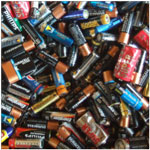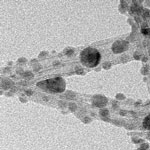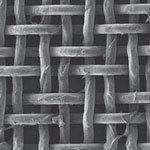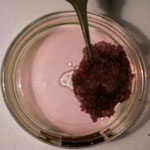Showing Spotlights 73 - 80 of 150 in category All (newest first):
 Many batteries still contain heavy metals such as mercury, lead, cadmium, and nickel, which can contaminate the environment and pose a potential threat to human health when batteries are improperly disposed of. Not only do the billions upon billions of batteries in landfills pose an environmental problem, they also are a complete waste of a potential and cheap raw material. Unfortunately, current recycling methods for many battery types, especially the small consumer type ones, don't make sense from an economical point of view since the recycling costs exceed the recoverable metals value. Researchers in India have carried out research to address the recycling of consumer-type batteries. They report the recovery of pure zinc oxide nanoparticles from spent Zn-Mn dry alkaline batteries.
Many batteries still contain heavy metals such as mercury, lead, cadmium, and nickel, which can contaminate the environment and pose a potential threat to human health when batteries are improperly disposed of. Not only do the billions upon billions of batteries in landfills pose an environmental problem, they also are a complete waste of a potential and cheap raw material. Unfortunately, current recycling methods for many battery types, especially the small consumer type ones, don't make sense from an economical point of view since the recycling costs exceed the recoverable metals value. Researchers in India have carried out research to address the recycling of consumer-type batteries. They report the recovery of pure zinc oxide nanoparticles from spent Zn-Mn dry alkaline batteries.
Dec 1st, 2011
 Breath analysis has been recognized as an increasingly accurate diagnostic method to link specific gaseous components in human breath to medical conditions and exposure to chemical compounds. Sampling breath is also much less invasive than testing blood, can be done very quickly, and creates as good as no biohazard waste. A recent review article in Environmental Science and Technology focuses on breath analysis as a tool for assessing environmental exposure and provides a good overview of the current state of diagnostic tools, leading studies in this field, and emerging technologies for hand-held breath analyzers. After describing the basics of breath analysis as a diagnostic tool, the authors discuss emerging chemical sensor technology ('electronic noses'), in particular two nanotechnology-based approaches, that are suitable to identify target analytes in breath.
Breath analysis has been recognized as an increasingly accurate diagnostic method to link specific gaseous components in human breath to medical conditions and exposure to chemical compounds. Sampling breath is also much less invasive than testing blood, can be done very quickly, and creates as good as no biohazard waste. A recent review article in Environmental Science and Technology focuses on breath analysis as a tool for assessing environmental exposure and provides a good overview of the current state of diagnostic tools, leading studies in this field, and emerging technologies for hand-held breath analyzers. After describing the basics of breath analysis as a diagnostic tool, the authors discuss emerging chemical sensor technology ('electronic noses'), in particular two nanotechnology-based approaches, that are suitable to identify target analytes in breath.
Oct 24th, 2011
 Back in 2008 we reported on nanotechnology solution for radioactive waste cleanup, specifically the use of titanate nanofibers as absorbents for the removal of radioactive ions from water. Now, the same group that developed these nanomaterials reports in a new study that the unique structural properties of titanate nanotubes and nanofibers make them superior materials for removal of radioactive cesium and iodine ions in water. Based on their earlier work, the researchers have now demonstrated a potentially cost-effective method to remediate cesium and iodine ions from contaminated water by using the unique chemistry of titanate nanotubes and nanofibers to chemisorb these ions.
Back in 2008 we reported on nanotechnology solution for radioactive waste cleanup, specifically the use of titanate nanofibers as absorbents for the removal of radioactive ions from water. Now, the same group that developed these nanomaterials reports in a new study that the unique structural properties of titanate nanotubes and nanofibers make them superior materials for removal of radioactive cesium and iodine ions in water. Based on their earlier work, the researchers have now demonstrated a potentially cost-effective method to remediate cesium and iodine ions from contaminated water by using the unique chemistry of titanate nanotubes and nanofibers to chemisorb these ions.
Oct 4th, 2011
 In the last couple of years, there has been particularly growing interest worldwide in exploring ways of finding suitable solutions to clean up oil spills and deal with industrial oily wastewater through use of nanomaterials. Key for the success of these materials is a high separation capacity, with resistance to oil fouling, and that are easily recyclable. Oil/water separation is an interfacial challenge, and novel materials designed to possess special wettability have different interaction and affinity for oil and water, thus can realize the separation. Until now, researches in this field all focus on materials with both hydrophobic and oleophilic properties. However, the oil-removing type of materials is easily fouled even blocked up by oils because of their intrinsic oleophilic property. A novel superhydrophilic and underwater superoleophobic hydrogel coated mesh can selectively separate water from oil/water mixtures effectively and without any extra power.
In the last couple of years, there has been particularly growing interest worldwide in exploring ways of finding suitable solutions to clean up oil spills and deal with industrial oily wastewater through use of nanomaterials. Key for the success of these materials is a high separation capacity, with resistance to oil fouling, and that are easily recyclable. Oil/water separation is an interfacial challenge, and novel materials designed to possess special wettability have different interaction and affinity for oil and water, thus can realize the separation. Until now, researches in this field all focus on materials with both hydrophobic and oleophilic properties. However, the oil-removing type of materials is easily fouled even blocked up by oils because of their intrinsic oleophilic property. A novel superhydrophilic and underwater superoleophobic hydrogel coated mesh can selectively separate water from oil/water mixtures effectively and without any extra power.
Sep 1st, 2011
 Notwithstanding all the buzz about renewable energy sources, the dirty facts are that coal accounts for 41% of electricity production worldwide. Since, realistically, coal will be a mainstay of electricity generation for many years to come, research into more environmentally friendly use of coal energy is picking up steam. One technology for more efficient power production centers around the solid oxide fuel cell (SOFC). Especially gasified carbon fuel cells offer great prospects for the most efficient utilization of a wide variety of carbonaceous solids fuels, including coal, biomass, and municipal solid waste. Researchers have now developed a self-cleaning technique that could allow solid oxide fuel cells to be powered directly by coal gas at operating temperatures as low as 750 degrees Celsius.
Notwithstanding all the buzz about renewable energy sources, the dirty facts are that coal accounts for 41% of electricity production worldwide. Since, realistically, coal will be a mainstay of electricity generation for many years to come, research into more environmentally friendly use of coal energy is picking up steam. One technology for more efficient power production centers around the solid oxide fuel cell (SOFC). Especially gasified carbon fuel cells offer great prospects for the most efficient utilization of a wide variety of carbonaceous solids fuels, including coal, biomass, and municipal solid waste. Researchers have now developed a self-cleaning technique that could allow solid oxide fuel cells to be powered directly by coal gas at operating temperatures as low as 750 degrees Celsius.
Jun 28th, 2011
 Water treatment is important for human consumption and environmental protection. Non-trivial purification of water involves removal of toxic ions, organic impurities, microbes and their by-products as well as scooping oil spills. The removal of organic contaminants from water is a major industrial concern. The challenging goal here is to detect, decompose and remove contaminants present usually in low concentrations. Towards this end, different types of sorbent materials have been developed to date, the most common being activated carbon. Though the use of activated carbon is still considered to be one of the best method, the disposal of adsorbed contaminants along with the adsorbent is a major concern. Researchers in India have recently come up with an innovative method for organic pollutant removal from waste water.
Water treatment is important for human consumption and environmental protection. Non-trivial purification of water involves removal of toxic ions, organic impurities, microbes and their by-products as well as scooping oil spills. The removal of organic contaminants from water is a major industrial concern. The challenging goal here is to detect, decompose and remove contaminants present usually in low concentrations. Towards this end, different types of sorbent materials have been developed to date, the most common being activated carbon. Though the use of activated carbon is still considered to be one of the best method, the disposal of adsorbed contaminants along with the adsorbent is a major concern. Researchers in India have recently come up with an innovative method for organic pollutant removal from waste water.
Jun 7th, 2011
 Several manufacturers are incorporating nano-sized particles of silver into, among other things, garments like socks and shirts to kill bacteria that cause odor. But does the silver stay in the socks or T-shirts? And what happens to it if it washes out? Also, what is the climate footprint of producing the required nanosilver? To answer these questions, a group of researchers have performed a cradle-to-grave life cycle assessment to compare nanosilver T-shirts with conventional T-shirts with and without biocidal treatment. For their assessment, the team used conventional T-shirts treated with triclosan, a commonly applied biocide to prevent textiles from emitting undesirable odors. The results show significant differences in environmental burdens between nanoparticle production technologies.
Several manufacturers are incorporating nano-sized particles of silver into, among other things, garments like socks and shirts to kill bacteria that cause odor. But does the silver stay in the socks or T-shirts? And what happens to it if it washes out? Also, what is the climate footprint of producing the required nanosilver? To answer these questions, a group of researchers have performed a cradle-to-grave life cycle assessment to compare nanosilver T-shirts with conventional T-shirts with and without biocidal treatment. For their assessment, the team used conventional T-shirts treated with triclosan, a commonly applied biocide to prevent textiles from emitting undesirable odors. The results show significant differences in environmental burdens between nanoparticle production technologies.
May 13th, 2011
 In the wake of the BP oil spill in the Gulf of Mexico we published a general overview of the wide variety of nanomaterials and nanotechnologies that offer significant promise for oil spill cleanup and recovery. One problem with many existing solutions though is that they are one-offs, i.e. one they absorb oil they can't be re-used and need to be disposed of (which could in turn create secondary pollution effects). Ideally, any oil absorbent material used during ocean oil spills should be reusable and with special wettability that could controllably capture and release oil pollution repeatedly. Addressing this issue, researchers have now created an underwater water/solid interface inspired by fish scales. The surface of this new material shows superamphiphobicity in air and superoleophilicity under water, allowing it to be repeatedly used to capture and collect oil droplets in water.
In the wake of the BP oil spill in the Gulf of Mexico we published a general overview of the wide variety of nanomaterials and nanotechnologies that offer significant promise for oil spill cleanup and recovery. One problem with many existing solutions though is that they are one-offs, i.e. one they absorb oil they can't be re-used and need to be disposed of (which could in turn create secondary pollution effects). Ideally, any oil absorbent material used during ocean oil spills should be reusable and with special wettability that could controllably capture and release oil pollution repeatedly. Addressing this issue, researchers have now created an underwater water/solid interface inspired by fish scales. The surface of this new material shows superamphiphobicity in air and superoleophilicity under water, allowing it to be repeatedly used to capture and collect oil droplets in water.
May 9th, 2011
 Many batteries still contain heavy metals such as mercury, lead, cadmium, and nickel, which can contaminate the environment and pose a potential threat to human health when batteries are improperly disposed of. Not only do the billions upon billions of batteries in landfills pose an environmental problem, they also are a complete waste of a potential and cheap raw material. Unfortunately, current recycling methods for many battery types, especially the small consumer type ones, don't make sense from an economical point of view since the recycling costs exceed the recoverable metals value. Researchers in India have carried out research to address the recycling of consumer-type batteries. They report the recovery of pure zinc oxide nanoparticles from spent Zn-Mn dry alkaline batteries.
Many batteries still contain heavy metals such as mercury, lead, cadmium, and nickel, which can contaminate the environment and pose a potential threat to human health when batteries are improperly disposed of. Not only do the billions upon billions of batteries in landfills pose an environmental problem, they also are a complete waste of a potential and cheap raw material. Unfortunately, current recycling methods for many battery types, especially the small consumer type ones, don't make sense from an economical point of view since the recycling costs exceed the recoverable metals value. Researchers in India have carried out research to address the recycling of consumer-type batteries. They report the recovery of pure zinc oxide nanoparticles from spent Zn-Mn dry alkaline batteries. 
 Subscribe to our Nanotechnology Spotlight feed
Subscribe to our Nanotechnology Spotlight feed





